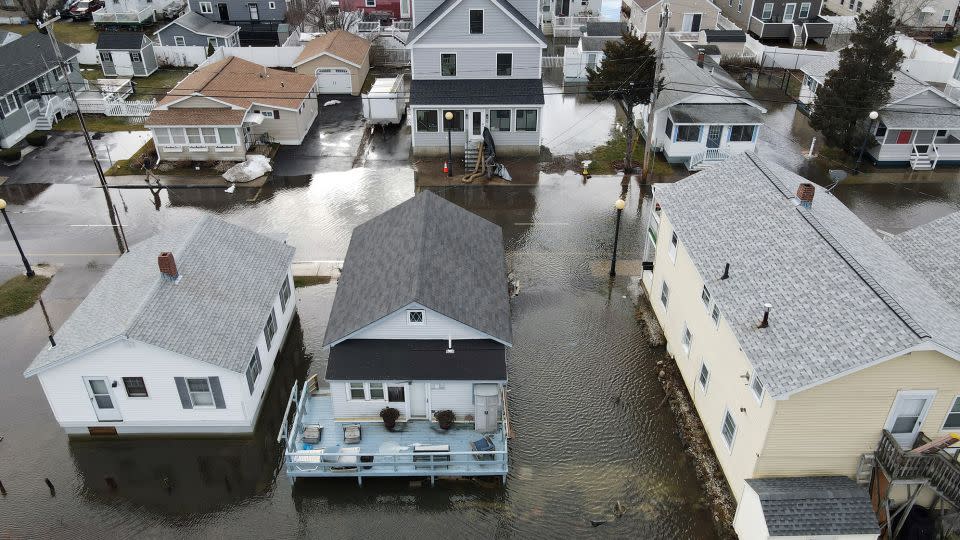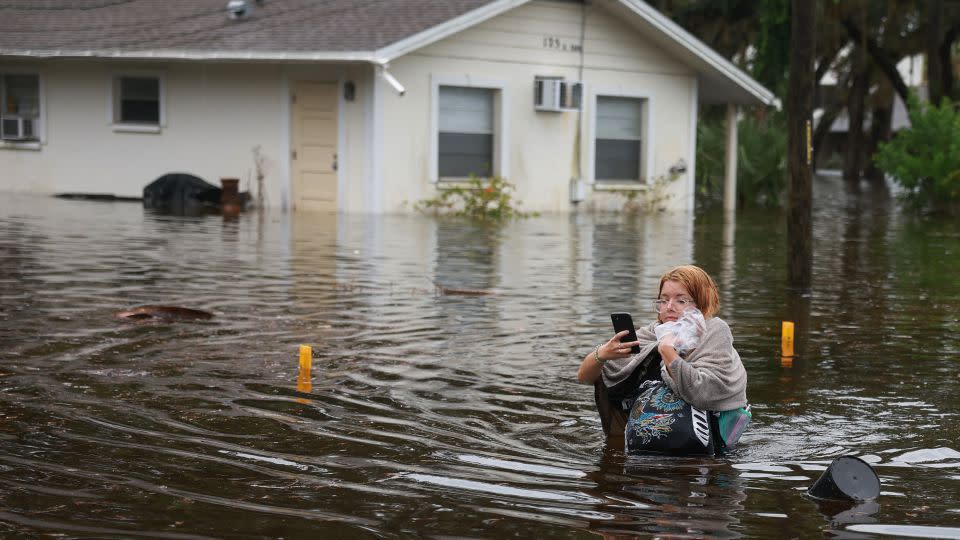For years, the fight against climate change was symbolized by one number: 1.5.
Since countries agreed in 2015 on the ambition to limit global warming to 1.5 degrees Celsius above pre-industrial levels, this number has become synonymous with averting catastrophic climate change.
But what if the battle to prevent global warming from exceeding this limit is already lost?
Some leading scientists argue that this is the case and that it is irresponsible not to sugar coat the truth. For others, that view is not only wrong, but even ‘dangerous’.
It was famed climate scientist James Hansen whose comments fueled the debate. In November, he declared the 1.5 degree limit “deader than a doornail,” saying it was a failure of the scientific community “not to make it clear to political leaders what the situation is.”
The pace of global warming is accelerating, he said at a news conference in November, and the world is certain to move past 1.5 degrees of warming. “Anyone who understands physics knows that.”
Hansen’s words have gained power: he is widely seen as the first scientist to publicly sound the alarm about climate change in the 1980s. But other scientists have pushed back hard.

“I have three degrees in physics and I can tell you that Jim is wrong,” said Michael Mann, a leading climate scientist at the University of Pennsylvania, referring to Hansen. The problem isn’t physics, it’s politics, he told CNN. “And political obstacles can be overcome.”
The reaction of Friederike Otto, a climate scientist at Imperial College London’s Grantham Institute, was even more blunt. “I think that’s a really stupid thing to say,” she told reporters in November. “Right now (1.5 degrees) is within reach and pretending that it isn’t only leads to us doing nothing for longer.”
Disagreements about climate science are not uncommon: our planet is a very complex system, and the nature of reaching consensus usually starts with scientists disagreeing.
But as global warming fuels extreme weather events — such as heat waves, cyclones and even fierce winter storms like the ones that tore through parts of the United States — the debate over the future of 1.5 is becoming unusually heated.
Extraordinary heat
As many parts of the US and Europe experience an Arctic blast of brutally cold air, it can be hard to remember just how hot 2023 was. Last year saw unprecedented global temperatures, with heat records plummeting around the world.
El Niño – a natural climate phenomenon that is raising the Earth’s average temperature – collided with the long-term trend of global warming, making 2023 the hottest year on record. According to data from the Copernicus Climate Change Service, this year the temperature exceeded the 1.5 degree limit in no time.
Although scientists are most concerned about long-term warming over many years, not just one, 2023’s record heat was a clear warning sign. If the world exceeds the 1.5 degree limit in the long term, scientists say the impacts of climate change will begin to exceed the ability of people and ecosystems to adapt.
But every fraction of a degree matters, and climate chaos is already unfolding.


“It is not the case that everything is fine before 1.5 hours and that after 1.5 hours an asteroid will fall on our heads,” Otto told CNN. Keeping warming below 1.5 degrees is not a physical threshold, but a political goal, she said.
In just a few years, the world has warmed from 1 degree Celsius above pre-industrial levels to about 1.2 degrees today – fractions of a degree that have translated into record-breaking extreme weather.
For Hansen, the recent global heat provides compelling evidence that 1.5 is dead. “I haven’t spent much time arguing this point… because I know nature is busy proving us right,” he told CNN.
He predicts that by May the planet will have experienced a 12-month period of average temperatures 1.6 to 1.7 degrees higher than pre-industrial levels.
“For all practical purposes we are only looking at 1.5 degrees in the rear view mirror,” he said.
Is climate change accelerating?
Central to Hansen’s argument is his much-discussed claim that the planet is warming much faster than predicted.
He points out the imbalance between the energy that comes in from the sun and that which comes out through the heat that radiates into space. This imbalance has doubled, meaning global warming is escalating, he argued in a November paper he co-authored with more than a dozen other scientists.
The article’s scientists attribute this mainly to successful global efforts to tackle shipping pollution.
Ships burn fossil fuels that produce carbon emissions, which have a significant impact on global warming. But ship exhaust fumes also contain sulfur dioxide. In what may seem like a strange twist, the pollutant – which is highly dangerous to human health – has a global cooling impact as its particles reflect sunlight away from Earth.
Hansen’s research predicts that the world will exceed the long-term standard of 1.5 degrees this decade, and 2 degrees before 2050. That would mean the world has failed to achieve the central goal of the Paris Agreement on climate change, under which countries pledged to limit warming to well below 2 degrees.


Bill McGuire, emeritus professor of earth sciences at University College London, shares Hansen’s concerns about the pace of change.
“The energy balance of our world is now massively out of balance,” McGuire told CNN, adding that it is “downright terrifying.”
But for many other scientists, there is simply no evidence that global warming is accelerating. At least not yet.
Chris Smith, a climate modeling expert at the University of Leeds in Britain, said it was too early to make that claim. “We would actually need three or four years of data all pointing in the same direction,” he told CNN.
Last year’s unprecedented heat was amplified by El Niño, Mann said, and “does not imply a change in the trend line.”
The pace of global warming accelerated after the 1970s as clean air laws reduced air pollution, but since then “the planet has warmed at a roughly constant rate,” he said. The reality is bad enough, he added. “There’s no need to exaggerate.”
Samantha Burgess, deputy director of Copernicus, said there have been recent climate events that scientists have struggled to understand, including record-breaking ocean temperatures in 2023.
But in terms of Hansen’s warning about the significant global warming impact of cleaning up shipping pollution, “we’re not seeing the signal,” she said.
Why 1.5 matters
Few scientists will dispute that the world faces a difficult path to limiting warming to 1.5 degrees. Even with current climate policies, the planet is on track for warming of almost 3 degrees.
In some ways, the divide between them is essentially a debate about the value of having the 1.5 degree limit.
If we say that 1.5 degrees is dead, Otto said, “for many people that probably means the conclusion: ‘Okay, then it’s not even worth trying.’”
Smith said there is a risk of a “fatalistic narrative that is actually quite dangerous”, potentially convincing leaders to think “we have failed, anything goes now”.
Staying below 1.5 degrees will be “very difficult”, but it is too early to say it is impossible, he told CNN.
Mann said it is “irresponsible” to claim that 1.5 degrees is death, when the world can avoid crossing the threshold by making substantial and immediate reductions in carbon pollution.
McGuire has taken the opposite view. There is no feasible way for the world to meet this limit, which would require a near halving of emissions by 2030, he said. “To suggest otherwise is duplicitous and misrepresents where we stand.” Framing 1.5 as a ‘target’ to be achieved, rather than as a limit to stay below, has created the illusion that we have more time than we do to tackle the crisis, he said, and has allowed countries and companies to continue burning fossil fuels.
But one of the main concerns is that if politicians abandon 1.5 degrees, they will not aim to limit global warming to 1.6 or 1.7 degrees, but will instead focus on 2 degrees – the upper limit that countries committed to in the 2015 Paris Agreement.
“That is an enormous danger, and that would be truly catastrophic,” said Otto.
Between 1.5 and 2 degrees lies a disaster: there is a risk of triggering a whole series of climate tipping points, including the melting of the ice cap and the mass death of coral reefs, and the lives and livelihoods of millions of people.
Probably next year we will reach 1.5 degrees as global average temperature, Otto said. “Whether we stay there, or how much above that, is really still a political question and it is within our gift to change that.”
For more CNN news and newsletters, create an account at CNN.com